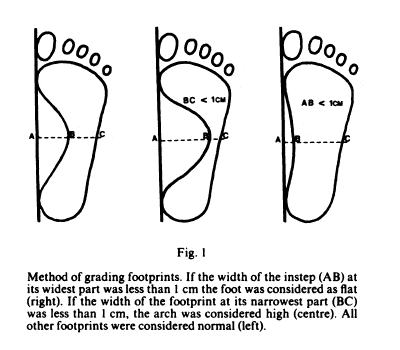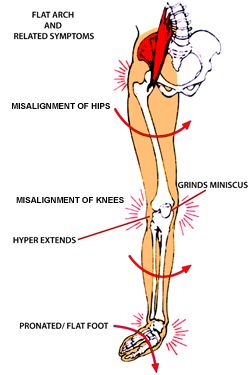Why Does Everything Hurt? You may be suffering from weak arches. Let’s discuss the phenomenon of collapsed arches, common causes, weak arches symptoms, and the repercussions of not correcting them.
What do I mean by arches? Let’s recall that sunny July day when you were 12 years old at the water park. There you are, waiting in line for the SUPERSLIDER 5000, holding an inner tube twice your size, leaving a trail of wet footprints in the hot concrete. Do you remember what they looked like? Did your entire foot leave a print? Or, was the inside of your foot missing?
If it was, your arches were intact. If it wasn’t, your feet probably hurt after running around barefoot on hard cement all day.
The proper name for a collapsed arch is ‘pes planus’ and it is a collapse of the ‘longitudinal arch’ of the foot. If that’s ever a jeopardy question, please give credit to Physio Logic.
Common causes for weak arches include:
- an abnormality at birth
- stretched or torn ligaments or tendons
- broken or dislocated bones
- and more commonly, damage or inflammation of the posterior tibial tendon (PTT) which connects to the middle of the longitudinal arch and holds it up like a sling.
Common symptoms of pes planus are feet that tire easily, painful arches, swelling along the inside of your feet, difficulty moving your feet, and knee, hip, and back pain. It’s easy to conceptualize the first four consequences of not addressing this condition, but why the leg and back pain? I was definitely present that day in first-grade science and I’m pretty sure the foot bone is not connected to the backbone. Although that’s technically true, what happens at the feet has tremendous implications for the rest of the musculoskeletal system.

Ultimately, this unnatural force can cause idiopathic knee pain or knee pain that seems to come from nowhere with no history of injury or trauma. That’s Jeopardy freebie number two, by the way. When that happens, there is then a tendency for the hips to adduct and internally rotate. This alignment of the hip can cause tearing or pinching of the labrum, or the ligamentous capsule that stabilizes the hip joint, resulting in hip pain usually localized to the groin and often described as ‘sharp’ or ‘pinching.’ It also puts the gluteal muscles, which are involved in lateral hip stability, on slack which impairs their ability to stabilize the pelvis.
In order to have a healthy spine, and in order to maintain good spinal alignment and ultimately to avoid back pain, pelvic stability is critical! Therefore, the foot bone is most definitely connected to the backbone.
I know what you’re thinking; your waterpark footprints had the inside intact and now you’re going to have knee, hip, and back pain forever, right? Wrong! This is where consulting with a Physical Therapist or Chiropractor becomes integral. By lifting your arches through strengthening of the tibialis posterior muscles; by strengthening your gluteals to accept this new alignment at the knees and hips; by sealing the deal with a strong core, you can significantly relieve those aches and pains that we all tend to accept as ‘part of life.’
Moral of this story? It’s true, life wears and tears; it demands our attention to the point where we stop listening when our body is trying to tell us something. But, it is never too late to start listening because we now understand, with some degree of confidence, that sore feet at 20 can cause back pain at 40.
If you don’t speak the same language as your body, and you’re unsure of what to do, come find a physical translator at Physio Logic and let’s all get on the same page… for your health! Give us call or you can start by filling out the form below.
